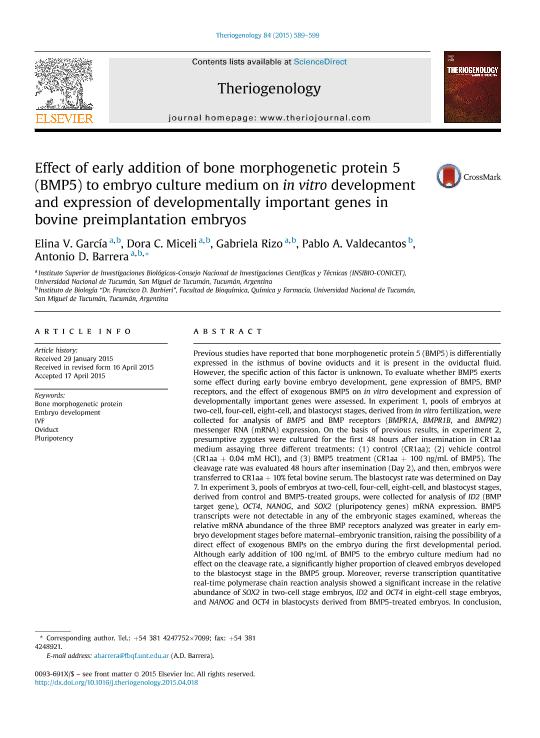Mostrar el registro sencillo del ítem
dc.contributor.author
Garcia, Elina Vanesa

dc.contributor.author
Miceli, Dora Cristina

dc.contributor.author
Rizo, Gabriela

dc.contributor.author
Valdecantos, Pablo Alberto

dc.contributor.author
Barrera, Antonio Daniel

dc.date.available
2018-06-08T23:45:18Z
dc.date.issued
2015-09
dc.identifier.citation
Garcia, Elina Vanesa; Miceli, Dora Cristina; Rizo, Gabriela; Valdecantos, Pablo Alberto; Barrera, Antonio Daniel; Effect of early addition of bone morphogenetic protein 5 (BMP5) to embryo culture medium on in vitro development and expression of developmentally important genes in bovine preimplantation embryos; Elsevier Science Inc; Theriogenology; 84; 4; 9-2015; 589-599
dc.identifier.issn
0093-691X
dc.identifier.uri
http://hdl.handle.net/11336/48042
dc.description.abstract
Previous studies have reported that bone morphogenetic protein 5 (BMP5) is differentially expressed in the isthmus of bovine oviducts and it is present in the oviductal fluid. However, the specific action of this factor is unknown. To evaluate whether BMP5 exerts some effect during early bovine embryo development, gene expression of BMP5, BMP receptors, and the effect of exogenous BMP5 on in vitro development and expression of developmentally important genes were assessed. In experiment 1, pools of embryos at two-cell, four-cell, eight-cell, and blastocyst stages, derived from in vitro fertilization, were collected for analysis of BMP5 and BMP receptors (BMPR1A, BMPR1B, and BMPR2) messenger RNA (mRNA) expression. On the basis of previous results, in experiment 2, presumptive zygotes were cultured for the first 48 hours after insemination in CR1aa medium assaying three different treatments: (1) control (CR1aa); (2) vehicle control (CR1aa + 0.04 mM HCl), and (3) BMP5 treatment (CR1aa + 100 ng/mL of BMP5). The cleavage rate was evaluated 48 hours after insemination (Day 2), and then, embryos were transferred to CR1aa + 10% fetal bovine serum. The blastocyst rate was determined on Day 7. In experiment 3, pools of embryos at two-cell, four-cell, eight-cell, and blastocyst stages, derived from control and BMP5-treated groups, were collected for analysis of ID2 (BMP target gene), OCT4, NANOG, and SOX2 (pluripotency genes) mRNA expression. BMP5 transcripts were not detectable in any of the embryonic stages examined, whereas the relative mRNA abundance of the three BMP receptors analyzed was greater in early embryo development stages before maternal?embryonic transition, raising the possibility of a direct effect of exogenous BMPs on the embryo during the first developmental period. Although early addition of 100 ng/mL of BMP5 to the embryo culture medium had no effect on the cleavage rate, a significantly higher proportion of cleaved embryos developed to the blastocyst stage in the BMP5 group. Moreover, reverse transcription quantitative real-time polymerase chain reaction analysis showed a significant increase in the relative abundance of SOX2 in two-cell stage embryos, ID2 and OCT4 in eight-cell stage embryos, and NANOG and OCT4 in blastocysts derived from BMP5-treated embryos. In conclusion, our results report that early addition of BMP5 to the embryo culture medium had a positive effect on the blastocyst rate and affected the relative expression of BMP target and pluripotency genes, suggesting that BMP5 could play an important role in the preimplantation development of bovine embryos.
dc.format
application/pdf
dc.language.iso
eng
dc.publisher
Elsevier Science Inc

dc.rights
info:eu-repo/semantics/openAccess
dc.rights.uri
https://creativecommons.org/licenses/by-nc-sa/2.5/ar/
dc.subject
Bone Morphogenetic Protein
dc.subject
Embryo Development
dc.subject
Ivf
dc.subject
Oviduct
dc.subject
Pluripotency
dc.subject.classification
Otras Ciencias Biológicas

dc.subject.classification
Ciencias Biológicas

dc.subject.classification
CIENCIAS NATURALES Y EXACTAS

dc.title
Effect of early addition of bone morphogenetic protein 5 (BMP5) to embryo culture medium on in vitro development and expression of developmentally important genes in bovine preimplantation embryos
dc.type
info:eu-repo/semantics/article
dc.type
info:ar-repo/semantics/artículo
dc.type
info:eu-repo/semantics/publishedVersion
dc.date.updated
2018-05-04T21:44:49Z
dc.journal.volume
84
dc.journal.number
4
dc.journal.pagination
589-599
dc.journal.pais
Estados Unidos

dc.description.fil
Fil: Garcia, Elina Vanesa. Consejo Nacional de Investigaciones Científicas y Técnicas. Centro Científico Tecnológico Conicet - Tucumán. Instituto Superior de Investigaciones Biológicas. Universidad Nacional de Tucumán. Instituto Superior de Investigaciones Biológicas; Argentina. Universidad Nacional de Tucumán. Facultad de Bioquímica, Química y Farmacia. Instituto de Biología; Argentina
dc.description.fil
Fil: Miceli, Dora Cristina. Consejo Nacional de Investigaciones Científicas y Técnicas. Centro Científico Tecnológico Conicet - Tucumán. Instituto Superior de Investigaciones Biológicas. Universidad Nacional de Tucumán. Instituto Superior de Investigaciones Biológicas; Argentina. Universidad Nacional de Tucumán. Facultad de Bioquímica, Química y Farmacia. Instituto de Biología; Argentina
dc.description.fil
Fil: Rizo, Gabriela. Consejo Nacional de Investigaciones Científicas y Técnicas. Centro Científico Tecnológico Conicet - Tucumán. Instituto Superior de Investigaciones Biológicas. Universidad Nacional de Tucumán. Instituto Superior de Investigaciones Biológicas; Argentina. Universidad Nacional de Tucumán. Facultad de Bioquímica, Química y Farmacia. Instituto de Biología; Argentina
dc.description.fil
Fil: Valdecantos, Pablo Alberto. Universidad Nacional de Tucumán. Facultad de Bioquímica, Química y Farmacia; Argentina
dc.description.fil
Fil: Barrera, Antonio Daniel. Consejo Nacional de Investigaciones Científicas y Técnicas. Centro Científico Tecnológico Conicet - Tucumán. Instituto Superior de Investigaciones Biológicas. Universidad Nacional de Tucumán. Instituto Superior de Investigaciones Biológicas; Argentina. Universidad Nacional de Tucumán. Facultad de Bioquímica, Química y Farmacia. Instituto de Biología; Argentina
dc.journal.title
Theriogenology

dc.relation.alternativeid
info:eu-repo/semantics/altIdentifier/doi/https://dx.doi.org/10.1016/j.theriogenology.2015.04.018
dc.relation.alternativeid
info:eu-repo/semantics/altIdentifier/url/https://www.sciencedirect.com/science/article/pii/S0093691X15002022
Archivos asociados
